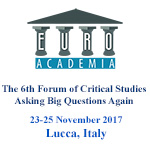Euroacademia Conferences
 Europe Inside-Out: Europe and Europeanness Exposed to Plural Observers (9th Edition) April 24 - 25, 2020
Europe Inside-Out: Europe and Europeanness Exposed to Plural Observers (9th Edition) April 24 - 25, 2020 Identities and Identifications: Politicized Uses of Collective Identities (9th Edition) June 12 - 13, 2020
Identities and Identifications: Politicized Uses of Collective Identities (9th Edition) June 12 - 13, 2020 8th Forum of Critical Studies: Asking Big Questions Again January 24 - 25, 2020
8th Forum of Critical Studies: Asking Big Questions Again January 24 - 25, 2020 Re-Inventing Eastern Europe (7th Edition) December 13 - 14, 2019
Re-Inventing Eastern Europe (7th Edition) December 13 - 14, 2019 The European Union and the Politicization of Europe (8th Edition) October 25 - 26, 2019
The European Union and the Politicization of Europe (8th Edition) October 25 - 26, 2019 Identities and Identifications: Politicized Uses of Collective Identities (8th Edition) June 28 - 29, 2019
Identities and Identifications: Politicized Uses of Collective Identities (8th Edition) June 28 - 29, 2019 The European Union and the Politicization of Europe (7th Edition) January 25 - 26, 2019
The European Union and the Politicization of Europe (7th Edition) January 25 - 26, 2019 7th Forum of Critical Studies: Asking Big Questions Again November 23 - 24, 2018
7th Forum of Critical Studies: Asking Big Questions Again November 23 - 24, 2018 Europe Inside-Out: Europe and Europeanness Exposed to Plural Observers (8th Edition) September 28 - 30, 2018
Europe Inside-Out: Europe and Europeanness Exposed to Plural Observers (8th Edition) September 28 - 30, 2018 Identities and Identifications: Politicized Uses of Collective Identities (7th Edition) June 14 - 15, 2018
Identities and Identifications: Politicized Uses of Collective Identities (7th Edition) June 14 - 15, 2018
Autophagy: Science, Technology, Economics, Arts, Metaphor
-
-

-
Presentation speakers
- Roger Davis, Department of Humanities and Social Sciences, Red Deer College, Canada
Abstract:
This paper will read the metaphors of autophagy, both inside and outside the discipline of the physical sciences, to argue that autophagy relies on the metaphors of recycling and renewal at an historical moment of environmental crisis, economic austerity, and human catastrophe. Yoshinori Ohsumi won the Nobel Prize in Physiology or Medicine in 2016 for his work on cellular autophagy, a term which etymologically means “self-eating.” Autophagy is a process whereby cells self-cannibalize or recycle their own internal products as a means to maintain cellular health. The paper will trace how different disciplines adopt autophagy as a metaphor of positive growth or health. The disciplines then make a further metaphorical leap to scale up the processes and effects of autophagy—essentially moving from a cellular to a larger structural level—to show how each discipline is similarly beneficial in terms of “growth” or “health.” For example, in their 2015 book Beyond GDP, Matthew Kuperus Heun et al have made deliberate use of autophagy as a metaphor for new economic models in a contemporary, economically austere world. Elsewhere, autophagy as “self-eating” has been enacted in artistic areas such as Julia Ducournau’s 2016 film Raw and M. R. Carey’s 2014 novel The Girl with All the Gifts. With a focus on the disciplines of biological science, art, and economics, this paper will ask the big question of whether or not the metaphors of autophagy help solve global problems of waste accumulation, population growth, or resource scarcity. Is autophagy a workable model for areas outside of cellular biology, or is it a convenient small-scale natural process that we employ as a metaphor to inculcate a tantalizing belief that we can autonomically solve our self-created problems?
-
Related Presentations

Understanding the Trembles of Nature: How Do Disaster Experiences Shape Bank Risk Taking?
- Jaap W. Bos
- Runliang Li

Rethinking China’s Revolutionary Identity in Transformation: Memory, Reflection, and Cultural Politics
- Mengqian Yuan
- Chu-Jie Chen

Post-Truth, Relativism and Music
- Wolfgang Marx

Metamorphoses in the City and the Place of Collective Memory: What Challenges?
- Joana Ribeiro Santos













